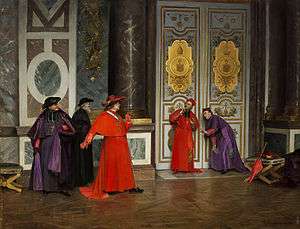Eavesdropping
Eavesdropping is the act of secretly or stealthily listening to the private conversation or communications of others without their consent.[1] The practice is widely regarded as unethical, and in many jurisdictions is illegal.

| This article is part of a series on |
| Information security |
|---|
| Related security categories |
| Threats |
|
| Defenses |
Etymology
The verb eavesdrop is a back-formation from the noun eavesdropper ("a person who eavesdrops"), which was formed from the related noun eavesdrop ("the dripping of water from the eaves of a house; the ground on which such water falls").[2]
An eavesdropper was someone who would hang from the eave of a building so as to hear what is said within. The PBS documentaries Inside the Court of Henry VIII (April 8, 2015)[3] and Secrets of Henry VIII’s Palace (June 30, 2013) include segments that display and discuss "eavedrops", carved wooden figures Henry VIII had built into the eaves (overhanging edges of the beams in the ceiling) of Hampton Court to discourage unwanted gossip or dissension from the King's wishes and rule, to foment paranoia and fear,[3] and demonstrate that everything said there was being overheard; literally, that the walls had ears.[4]
Techniques
Eavesdropping vectors include telephone lines, cellular networks, email, and other methods of private instant messaging. VoIP communications software is also vulnerable to electronic eavesdropping via infections such as trojans.[1]
Network attacks
Network eavesdropping is a network layer attack that focuses on capturing small packets from the network transmitted by other computers and reading the data content in search of any type of information.[5] This type of network attack is generally one of the most effective as a lack of encryption services are used. It is also linked to the collection of metadata. Those who perform this type of attack are generally black-hat hackers; however, government agencies, such as the National Security Agency, have also been connected.
History

See also
- Cellphone surveillance
- Computer surveillance
- ECHELON
- Espionage
- Fiber tapping
- Katz v. United States (1967)
- Global surveillance disclosures (2013–present)
- Keystroke logging
- Magic (cryptography)
- Man-in-the-middle attack
- Mass surveillance
- NSA warrantless surveillance controversy (December 2005 – 2006)
- Opportunistic encryption
- Party line
- People watching
- Privacy
- Secure communication
- Surveillance
- Telephone tapping
- Ultra
- Covert listening device
References
- Garner, p. 550
- "eavesdrop – Definition of eavesdrop in English by Oxford Dictionaries". Oxford Dictionaries – English.
- Inside the Court of Henry VIII. Public Broadcasting Service. April 8, 2016.
- Stollznow, Karen (August 7, 2014). "Eavesdropping: etymology, meaning, and some creepy little statues". KarenStollznow.com.
- "TeamMentor 3.5". vulnerabilities.teammentor.net. Retrieved 2019-09-27.
External links

